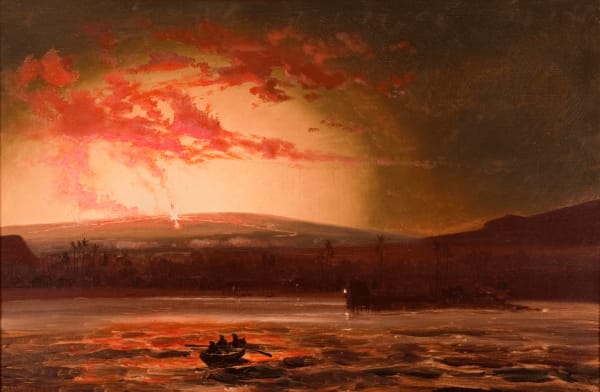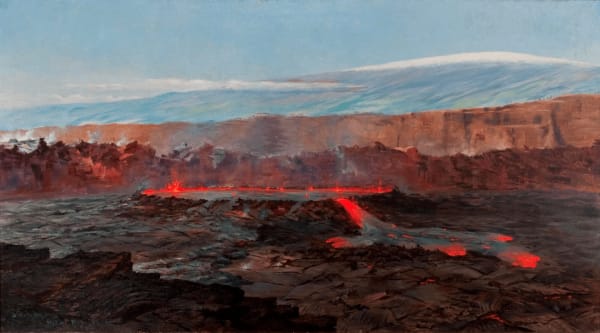The Volcano School (duplicate): Sensations & The Sublime
-
Overview
In the 1880s and 1890s, Mauna Loa, Hawaii's biggest volcano, kicked off an eruption that brought lava closer to the town of Hilo than ever before.
Hawaii residents and tourists alike flocked to the Big Island for a chance to see the eerie orange glow over the city of Hilo, and -- in the days before color photography -- painters were among the most eager to witness and recreate the explosive lava plumes and vibrant flows.
Painters such as Jules Tavernier, Charles Furneaux and Joseph D. Strong -- buoyed by a growing commercial interest in landscape paintings -- traveled to Hawaii and trekked across the rugged terrain on multi-day journeys. The sulfuric gases and intense heat of the volcanic vents made it impossible to set up an easel and canvas on site, but the artists sketched and took mental photographs that they then recreated in their studios.
Known today as the Volcano School, their work is Hawaii's version of plein air painting, and it brought the ghostly and wondrous images of Hawaii's volcanic eruptions to the masses 135 years ago. -
Artworks
-
I. Part I
この度、思文閣では、戦後日本の書芸術の景色を変え、現代美術史に大きな足跡を残した作家、森田子龍に焦点を当てた展覧会、「墨人 森田子龍」を開催します。
1950年代初頭、戦後の混沌の様相をなお残していた日本で、伝統芸術である書をめぐる革新的な運動が起こります。やがて欧米の抽象絵画と交錯した日本の前衛書は、50年代後半には国際美術の舞台へ躍り出ます。それは東洋と西洋、伝統芸術の書と現代美術の抽象絵画が交わる、美術史上かつてない驚くべきひと幕であり、その立役者こそ、伝統的なものを破壊するかたちでなく書芸術に新たな概念を吹き込み、造形芸術としての書を世界に知らしめた作家、森田子龍でした。
子龍が1951年に創刊し、全300号を編集した書芸術総合誌「墨美」は、他に類のない新しい芸術媒体であり、50年代から60年代にかけてカテゴリーや国を超えて、芸術家の交流を促しました。1952年、既存の書壇の因習を打破し現代書芸術を再確立すべく、4人の同志と共に子龍が京都で結成した前衛書グループ、墨人会は、戦後日本の前衛書運動を代表する存在として60年代にかけて海外に積極的に進出していきます。 -
II. Part Two
墨人会発足の翌1953年、京阪神の芸術家がジャンルを超えて集まり、現代美術懇談会(ゲンビ)がスタートします。その例会で、具体美術協会のリーダーとなる吉原治良が、文字性は造形美術として「非常に大きい書道の制約」と指摘し、書は文字の拘束から解放されるべきだと述べます。これに対して、子龍は、文字は制約ではなく、文字という骨格があるからこそ、書は空間的限定と時間性を内包した場をもつことができる、と書における文字性に、一貫したこだわりを見せます。












